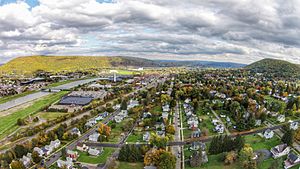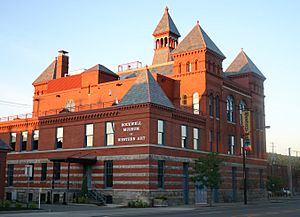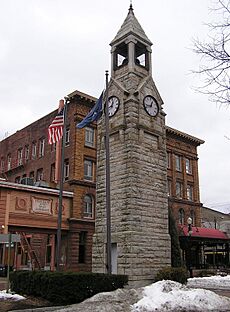Corning, New York facts for kids
Quick facts for kids
Corning, New York
|
||
|---|---|---|
 |
||
|
||
| Nickname(s):
Crystal City
|
||
| Country | United States | |
| State | New York | |
| County | Steuben | |
| Government | ||
| • Type | Council-Manager | |
| Area | ||
| • Total | 3.26 sq mi (8.45 km2) | |
| • Land | 3.08 sq mi (7.99 km2) | |
| • Water | 0.18 sq mi (0.46 km2) | |
| Elevation | 932 ft (284 m) | |
| Population
(2020)
|
||
| • Total | 10,551 | |
| • Density | 3,421.21/sq mi (1,321.04/km2) | |
| Time zone | UTC−5 (Eastern (EST)) | |
| • Summer (DST) | UTC−4 (EDT) | |
| ZIP codes |
14830-14831
|
|
| Area code(s) | 607 | |
| FIPS code | 36-18256 | |
| GNIS feature ID | 0947476 | |
| Website | Corning, New York | |
Corning is a city in Steuben County, New York, United States. It sits along the Chemung River. In 2020, about 10,551 people lived there.
The city is named after Erastus Corning. He was a businessman from Albany, New York who invested in the company that helped build the community. Corning is famous for being the home of Corning Incorporated. This big company makes glass and ceramic products for many uses.
Corning is about 220 miles (354 km) from both New York City and Toronto.
Contents
About Corning

The city of Corning is located on the western edge of the town of Corning. It is in the southeastern part of Steuben County, New York.
Corning is home to the Corning Museum of Glass. This museum has one of the world's largest collections of glass objects. These items range from ancient times to today. The museum also has the Rakow Library, a major research center for glass.
Another important place to visit is the Rockwell Museum. It has a large collection of Western American art. This art was gathered by Robert F. and Hertha Rockwell over 40 years.
American Style magazine has often called Corning one of the top small cities for arts in the U.S. Many of the city's cultural events and historic spots are in the Gaffer District.
Corning used to host the LPGA Corning Classic, a professional golf tournament, from 1979 to 2009. You can fly to Corning through the Elmira/Corning Regional Airport. This airport is in the nearby town of Big Flats.
In 2013, Rand McNally named Corning the "Most Fun" small town in America.
History of Corning
The first people settled near what is now Corning in 1796. Corning became a village in 1848 and a city in 1890. As the glass industry grew, Corning became known as the "Crystal City." Companies like Hawkes, Sinclair, and Hunt made beautiful cut glass there.
The first big industry in the Corning area was lumber. Early settlers used the rivers to float logs downstream to sell. This led to large mills being built. At one time, Corning's mills were said to be among the biggest in the world. When the trees ran out, the mills moved to new forests.
East of Corning, across the Chemung River, is Gibson. This was a part of the Chemung Canal system. The canal helped Corning grow by allowing goods to be shipped. Things like soft coal, timber, and grain were sent from Corning. In 1850, over 1,100 boats left Corning's port.
After the American Civil War, industries grew quickly in the area. Ingersoll Rand opened in Painted Post, just north of Corning, during this time.
Corning became a railroad town in the 1880s. Many smaller rail lines connected to the main tracks, linking communities. In 1912, a train crash near Corning killed 39 people.
Several historic buildings in Corning are listed on the National Register of Historic Places. These include the Jenning's Tavern, Corning Armory, and the Market Street Historic District.
The Great Flood of 1972
The flood of 1972 was a very important event for Corning. On June 22, 1972, the remains of Hurricane Agnes brought heavy rain to New York. Six to eight inches (203 mm) of rain fell in the Chemung River basin.
This caused the Chemung River to overflow its banks on June 23 at 4:00 a.m. By 9:00 a.m., the river reached its highest point and then began to go down. In the Corning area, eighteen people died, and there was a lot of damage.
The river went down quickly, leaving mud everywhere. You can still find this mud in some basements today. At the Corning Museum of Glass, there is a mark on a wall showing how high the floodwaters rose.
Geography
The Cohocton River and the Tioga River join just upstream from Corning. They form the Chemung River, which flows through the city. The river was important for power in the past and adds to the area's beauty today.
The river can flood easily because rain runs off the steep hills quickly. Today, a system of dams upstream from Corning helps control flooding.
Major highways connect in Corning. These include I-86, NY 17, NY 352, NY 414, and NY 415. I-99 and US 15 go south from Painted Post, west of Corning.
The city covers about 3.3 square miles (8.5 km2). Most of this is land, and a small part is water.
Climate
| Climate data for Corning, New York (1991–2020 normals, extremes 1992–present) | |||||||||||||
|---|---|---|---|---|---|---|---|---|---|---|---|---|---|
| Month | Jan | Feb | Mar | Apr | May | Jun | Jul | Aug | Sep | Oct | Nov | Dec | Year |
| Record high °F (°C) | 66 (19) |
71 (22) |
86 (30) |
91 (33) |
94 (34) |
95 (35) |
98 (37) |
100 (38) |
97 (36) |
84 (29) |
76 (24) |
69 (21) |
100 (38) |
| Mean daily maximum °F (°C) | 29.5 (−1.4) |
32.6 (0.3) |
41.5 (5.3) |
55.2 (12.9) |
67.6 (19.8) |
74.9 (23.8) |
79.1 (26.2) |
77.2 (25.1) |
70.1 (21.2) |
57.7 (14.3) |
44.9 (7.2) |
34.2 (1.2) |
55.4 (13.0) |
| Daily mean °F (°C) | 20.8 (−6.2) |
22.7 (−5.2) |
30.5 (−0.8) |
42.9 (6.1) |
54.6 (12.6) |
62.8 (17.1) |
67.1 (19.5) |
65.6 (18.7) |
58.4 (14.7) |
46.9 (8.3) |
35.8 (2.1) |
26.7 (−2.9) |
44.6 (7.0) |
| Mean daily minimum °F (°C) | 12.2 (−11.0) |
12.8 (−10.7) |
19.6 (−6.9) |
30.5 (−0.8) |
41.6 (5.3) |
50.6 (10.3) |
55.1 (12.8) |
54.0 (12.2) |
46.7 (8.2) |
36.2 (2.3) |
26.6 (−3.0) |
19.2 (−7.1) |
33.8 (1.0) |
| Record low °F (°C) | −20 (−29) |
−18 (−28) |
−15 (−26) |
6 (−14) |
22 (−6) |
33 (1) |
39 (4) |
41 (5) |
26 (−3) |
20 (−7) |
−1 (−18) |
−13 (−25) |
−20 (−29) |
| Average precipitation inches (mm) | 2.34 (59) |
1.92 (49) |
2.99 (76) |
3.37 (86) |
3.05 (77) |
4.18 (106) |
3.69 (94) |
3.86 (98) |
4.18 (106) |
3.60 (91) |
2.85 (72) |
2.66 (68) |
38.69 (983) |
| Average snowfall inches (cm) | 11.8 (30) |
11.3 (29) |
13.6 (35) |
2.2 (5.6) |
0.0 (0.0) |
0.0 (0.0) |
0.0 (0.0) |
0.0 (0.0) |
0.0 (0.0) |
0.2 (0.51) |
4.1 (10) |
10.0 (25) |
53.2 (135) |
| Average precipitation days (≥ 0.01 in) | 14.8 | 11.8 | 13.3 | 14.1 | 14.0 | 13.6 | 12.7 | 12.2 | 11.6 | 14.2 | 13.6 | 15.3 | 161.2 |
| Average snowy days (≥ 0.1 in) | 11.1 | 9.4 | 7.1 | 1.9 | 0.0 | 0.0 | 0.0 | 0.0 | 0.0 | 0.2 | 3.5 | 8.7 | 41.9 |
| Source: NOAA | |||||||||||||
People of Corning
In 2010, there were 11,183 people living in Corning. About 91.8% of the people were White. About 3.2% were Black or African American. About 1.8% were Asian. People of Hispanic or Latino background made up 2.4% of the population.
In 2000, about 26.2% of homes had children under 18. The average age in the city was 38 years old. About 13% of the population lived below the poverty line in 2000. By 2010, this number was 20.4%.
| Historical population | |||
|---|---|---|---|
| Census | Pop. | %± | |
| 1870 | 4,018 | — | |
| 1880 | 4,802 | 19.5% | |
| 1890 | 8,590 | 78.9% | |
| 1900 | 11,061 | 28.8% | |
| 1910 | 13,730 | 24.1% | |
| 1920 | 15,820 | 15.2% | |
| 1930 | 15,777 | −0.3% | |
| 1940 | 16,212 | 2.8% | |
| 1950 | 17,684 | 9.1% | |
| 1960 | 17,085 | −3.4% | |
| 1970 | 15,792 | −7.6% | |
| 1980 | 12,953 | −18.0% | |
| 1990 | 11,938 | −7.8% | |
| 2000 | 10,842 | −9.2% | |
| 2010 | 11,183 | 3.1% | |
| 2020 | 10,551 | −5.7% | |
| Sources: 1790–1950, 1960–1980, 1990–2000 |
|||
Schools in Corning
The Corning-Painted Post School District serves the area. It includes the City of Corning and the Village of Painted Post. The district has six public elementary schools, one public middle school, and one public high school.
In 2010, a plan was approved to change the secondary schools. The two middle schools combined into one building. The two high schools also combined into one campus. This project was finished by the 2014–2015 school year.
The district also works with a regional P-Tech school. It is called "The Greater Southern Tier STEM Academy." Some students go there for a program from grades 9 to 14.
Public Elementary Schools
- Calvin U. Smith
- Erwin Valley
- Frederick Carder
- Hugh W. Gregg
- William E. Severn
- Winfield Street
Public Middle Schools
- Corning Painted Post Middle School (since 2013)
Public High Schools
- Corning Painted Post High School (since 2013)
- High School Learning Center (HSLC)
Private Schools in Corning
- Corning Christian Academy (a school for grades P-12)
- The Alternative School for Math and Science (ASMS)
Higher Education
- Corning Community College
Fun Places to Visit
Downtown Corning
- Corning Museum of Glass: This museum is all about glass. You can learn about its art, history, science, and how it's made.
- The Gaffer District is the old part of Corning. It has restored buildings, shops, restaurants, and events all year.
- Market Street is Corning's main historic street. It is full of places to eat and shop.
- Centerway Square is in the middle of Market Street. It is a pedestrian area with a bandstand and benches. A restored historic clock tower is the main feature of the square.
Other Places in Corning
- Bloody Run – This area near Gorton Creek was a battle site. American generals fought Native American villagers here. It was called Bloody Run because the creek water was said to be bloody after the battle.
- Heritage Village of the Southern Finger Lakes – This is a "Living History" museum in Corning. It has the Benjamin Patterson Inn, built in 1796. The village also has a blacksmith shop, a one-room schoolhouse, and an 1850s log cabin.
- Horace D. Page Tunnel – This tunnel connects two parts of Denison Park. It was named after Horace D. Page.
Gallery
Famous People from Corning
- Alanson B. Houghton, a U.S. Congressman
- Amory "Amo" Houghton Jr., a politician
- Amory Houghton, a U.S. ambassador
- Charles C. B. Walker, a U.S. Congressman
- Christi Wolf, a champion bodybuilder and professional wrestler
- Duane Eddy (1938–2024), a Grammy Award-winning guitarist
- Edd Hall, a TV personality and announcer
- Eric Massa, a U.S. Congressman
- Frederick Carder, a glass artist
- Greg Keagle, an MLB baseball player
- Harvey Littleton, a glass artist
- James R. Houghton, chairman of Corning Inc.
- John N. Hungerford, a U.S. Congressman
- John Tillman, a lacrosse coach
- Joseph Costa, an aviation pioneer
- Katharine Houghton Hepburn (1878–1951), a social activist and mother of actress Katharine Hepburn
- Samuel Sevian, a chess prodigy
- Thomas S. Buechner (1926–2010), founding director of the Corning Museum of Glass
- Tom Reed, a U.S. Congressman
Sister Cities
See also
 In Spanish: Corning (Nueva York) para niños
In Spanish: Corning (Nueva York) para niños









